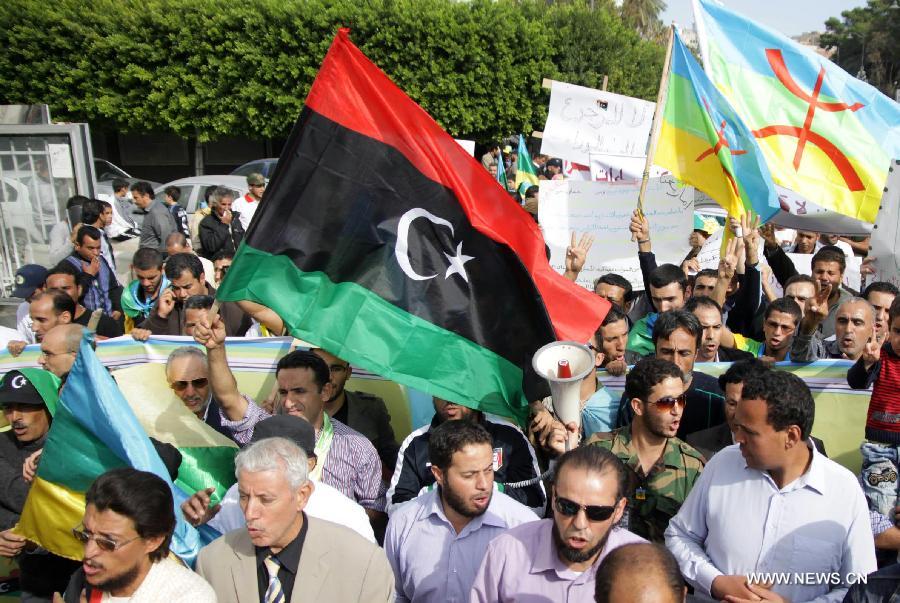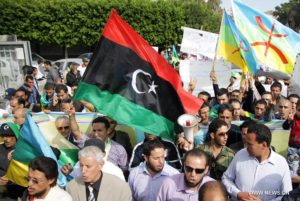A marginalized group in Libya revives their native language after the Arab Spring
By Natasha Turak February 5, 2015,
The main home of the Libyan Amazighs sits across the Nafusa mountain range in western Libya, currently enveloped in a blanket of snow. The Amazighs, also known as Berbers, number at about 600,000 in Libya, or 10% of the country’s population of six million. Amazighs are descended from the original Berber tribes of North Africa, who roamed from Morocco to the Nile until the Muslim conquests of the 7th century, when Arabs from Arabia settled in the countries that today speak predominantly Arabic. Amazighs have their own customs and their own language, called Tamazight, but this indigenous language was forced underground during the reign of Libya’s longtime dictator Muammar Gaddafi, who aggressively pursued complete Arabization of the country and oppressed ethnic minorities through his “Cultural Revolution” launched in 1973. Gaddafi’s draconian policies included imprisonment and torture of Amazighs who tried to teach or spread their language.
After the fall of Gaddafi during Libya’s 2011 uprising, as the revolutionary fervor of the Arab Spring swept across North Africa like a wildfire, the country descended into a spiral of conflict that continues unabated today. A power vacuum has resulted in numerous competing militias and tribes fighting each other for power, with two separate governments in different parts of the country claiming legitimacy. But amid the maelstrom, the Amazigh community found an opportunity—for the first time in decades, they were free to bring their language back to life. Over the past four years, Amazighs in both the Nafusa mountains and Zwara, another Amazigh enclave near the Tunisian border, have started building schools and running classes for children to bring the Tamazight language back into public use.
“The Amazigh generations from 1951 to 2011 didn’t have a chance at education in their mother language—that’s almost 63 years. Those generations were severely marginalized and discriminated against,” language activist Madghis Buzakhar told Euphrates.
Madghis is an Amazigh activist and co-founder of TIRA Research and Studies, a media center based in Tripoli, Libya providing classes and teaching resources for the Tamazight language. Madghis has dedicated years of his life toward enabling these young classes to exist and grow. In 2010 he was arrested, along with his twin brother Mazigh, and tortured in one of Gaddafi’s prisons after regime forces raided their home and discovered their library of Amazigh books. “They took us to Block 9 – the prison block reserved for executions and life sentences,” Madghis’s brother Mazigh told Euphrates over Skype. The brothers were released when the 2011 revolution hit, and their community played a significant role in fighting Gaddafi’s forces. As soon as they were able to, they began to set up the facilities for their language schools, with help from the local community.
“The first lessons in Tamazight, the Amazigh language, started in makeshift schools here, in the mountains, when the war was not even over,” Said Azabi, a school manager in the mountain town of Jadu, told Middle East Eye in an interview. He credits the selflessness of local volunteers for providing the school’s first books and teachers. His class currently hosts about 20 students.
Madghis cited funding and teacher training as some of the biggest challenges facing his movement. TIRA Research Center, which provides books and teacher training, is largely self-funded but receives help from the local community, particularly with workspace and facilities. “In 2013, TIRA for the first time contributed to designing the official year 3-4 Tamzight language curriculum and teacher’s guide book,” Madghis told Euphrates. When the first teaching classes were held, about 5 volunteers came. Now the teachers, both working and in training, number over 200.
In the coastal town of Zwara, there are 26 schools with about 60 teachers, and they offer 3 hours of language classes a week for first to fourth graders. Logistics are challenging, but according to the school’s leaders, the political situation is the biggest obstacle. “Libya is still in the mindset of Arabo-Islamization from the Gaddafi years,” Mazigh Buzakhar lamented. Based in Tripoli, Mazigh has played a leading role in activism for his community. “The draft Libyan Constitution names Libya an Arab, Islamic state,” he explained, which practically ensures marginalization of minority groups. “There is no provision to make Tamazight an official language, which it should be, as it was here before Arabic.” Furthermore, Mazigh sees his movement facing threats down the road; “We are a secular movement, a liberal movement—and we have been targeted by the Islamists.”
Meanwhile, General Khalil Haftar , leader of the main opposition militia, has been launching airstrikes against Zwara, making for a very unstable work environment. Nonetheless, students continue to attend their classes to learn a language that for so many decades could only be passed down orally, and within the confines of their families’ houses. The pupils wear coats and wool hats inside to stay warm, but that doesn’t damper their enthusiasm.
“Teaching Tamazight and opening discussion groups with teachers and young ones on Tamazight identity and history feels great after years of Amazigh movement struggle—years of preserving it and conserving it from the marginalization of the regime,” Madghis says. On his hopes for the future, he told Euphrates, “I see that this generation will make big steps forward for Tamazight in terms of education and its political position.”
The Berber Tamazight language is a member of the Afroasiatic language family, and is written with a script called Tifinagh, which looks completely different from Arabic and frankly from any language you’ve ever seen.
About 20 million people are estimated to speak variations of Tamazight across North Africa, with most of them concentrated in Morocco and Algeria. In Morocco, Tamazight has been taught and broadcasted since 1994, and as of 2011, it is the only country where Tamazight is an official language alongside Arabic. Morocco—as well as several cities across North Africa and the world with significant Maghrebi populations, including New York, Washington DC, Chicago, Montreal, Stockholm, and Paris—celebrated Amazigh New Year on January 13th, ringing in the year 2965 of the Amazigh calendar.
“When the world hears ‘Libya’ they think of Gaddafi, oil, terrorism and war”, writes the Facebook page Libyan Amazigh 101, a great source of pictures, information and conversation on all things relating to the Libyan Amazigh community. “Our goal with this page is to show the world that Libya is something much more than that, a country with a beautiful and incredibly diverse culture.”
Source: euphrates.org


